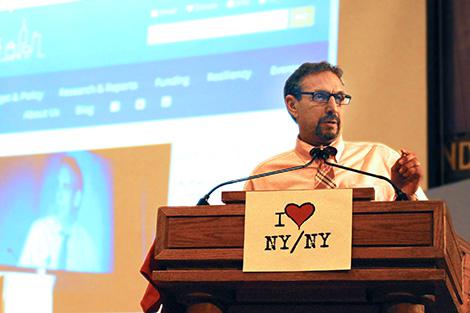
Learn more about our supportive housing and homeless outreach programs!
The current controversy over homelessness on the Upper West Side has made headlines across the country. But to former Goddard Riverside Executive Director Stephan Russo, it’s old news — part of an decades-long battle over who “belongs” on the Upper West Side and who doesn’t.
Asked to describe the history, he starts nearly 50 years ago, when the state began emptying out psychiatric hospitals. These institutions had rightly been found inhumane and abusive. The people being released from them were supposed to be offered supportive environments in the community, where they could thrive.
“They modeled it on group homes for people with develepmental disabilities which was a successful model for the most part,” Russo explains. “That would have been much more humane than the institutions. But they never created the programs and people ended up on the street.”
Simultaneously, the city was rapidly eliminating its most affordable form of housing. Single Room Occupancy buildings or SROs, sometimes called flophouses, typically rent out small rooms with shared bathrooms and kitchens. Many SROs offered pretty rough conditions—but they were a lifeline for people otherwise facing homelessness. “When the street population grew in the mid 80s, if you asked those people where they had lived, they always said their last housing was an SRO,” says Russo.
A third factor is the 1979 New York State Supreme Court decision in Callahan v. Carey, which established the right to shelter for homeless men in New York. (Later decisions extended the right to women and families.) That decision, Russo says, causes the city and state to focus on temporary shelter instead of the real solution to homelessness — permanent housing. “The fact that there actually is a right to shelter which has been litigated and is embedded in the constitution, it drives policy, whether you agree with it or not.”
By the mid-70s, according to lifelong Upper West Side resident Jeannine Jones, neighborhood sidewalks “teemed with alcoholic homeless.” In 1978 the New York Times wrote that the Upper West Side had “among the greatest concentrations of deinstitutionalized mental patients in the United States.”
Goddard got to work crafting solutions to the burgeoning crisis. Executive Director Bernie Wohl oversaw the launch of Project Reachout in 1979. By going out daily to talk to people in the street, Project Reachout was “the first to adopt a trust-building technique that has since been adopted widely,” wrote Dinesh Bhugra in his 2007 book Homelessness and Mental Health. “[M]any contacts were often needed before the individual gained sufficient confidence in the workers to establish some sort of tenuous relationship.” Our Homeless Outreach teams continue that work to this day.
Goddard also began buying SROs and converting them into affordable housing with built-in programs to help people transition out of life on the street. This became the supportive housing model, which along with street outreach is now considered an essential tool of the national effort to end homelessness.
Russo took over the helm at Goddard in 1998 and stayed on until 2017. He says one thing he learned from all his years fighting homelessness is that you need to work hard to get the community on your side. “We had meeting after meeting after meeting” to get neighbors on board with having supportive housing on their block, he recalls.
As it turned out, rather than these supportive housing residences being “blights” on the neighborhood, studies by the Furman Center at NYU and others found that their construction and renovation actually enhanced property values and improved the blocks. “If anything, having our Senate Residence renovated and run by a reputable organization helped reduce drug trafficking because we were good neighbors,” he says. “We shoveled the snow, took out the garbage and contributed to life on the block. The people in that building are just as much Upper West Siders as the people in the co-ops.”
Russo says another major takeaway from his experience is that the situation is far from hopeless. “Folks who are out on the street or who end up in shelters have for the most part experienced a major trauma in their lives. You have to try to address those individuals and that trauma,” he says.
“People can actually reenter society. And that’s what we see every day in supportive housing. There clearly are answers to this problem. It is not an unsolvable problem.”